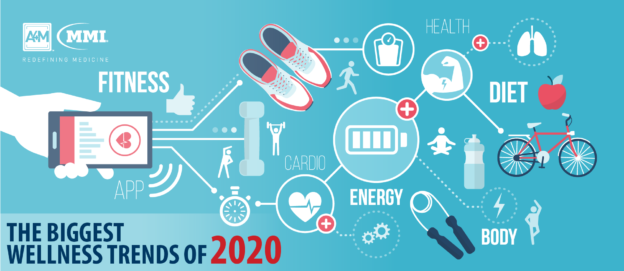Last year, the rise of cannabidiol (CBD), intermittent fasting, meditation, and many other health and wellness trends dominated the $4 trillion global wellness industry. As this segment of the market continues to grow rapidly, technologic advances, emerging clinical findings, and shifting priorities are likely to influence burgeoning wellness trends for the coming year. Recently, experts from across the world gathered to forecast the biggest health trends that will take over the global wellness industry in 2020 as part of the Global Wellness Summit (GWS).
Alongside a focus on fixing disrupted circadian rhythms and mental health-promoting devices, the most significant projected trends for the forthcoming year are outlined below:
Circadian Health Optimization
According to one of the world’s leading experts on circadian health and associate professor of medicine at Harvard University Dr. Steven Lockley: “The absolute key to healthy sleep and circadian rhythms is stable, regularly-timed daily light and dark exposure—our natural daily time cues.”
Today, humans have incredibly disrupted circadian rhythms as a result of increased screen time and travel, rising stress levels, and a 24/7 culture. Current research suggests that circadian rhythms influence a variety of bodily functions ranging from hormonal fluctuations to body temperature regulation. Most importantly, they can significantly influence sleep patterns, impacting productivity and health.
As part of the solution, the concept of circadian rhythm optimization centers around adjusting the daily schedule, dietary patterns, and environmental cues to sync up with the body’s internal clock. Experts at the Global Wellness Summit predict an increased amount of people shifting their work schedules in accordance with their chronotypes, which The Sleep Foundation describes as the natural pattern by which people sleep and wake best, in an effort to optimize performance and productivity.
“Given that most of our body systems express circadian rhythms, ensuring proper alignment of our internal circadian clocks,” Dr. Lockley further explains, “starting with the management of lighting, will have major impacts on human health.”
Mental Health Technology
The National Institute of Mental Health estimates that over 42% of 46.6 million adults with mental illness in the United States received mental health treatment in 2017. In addition, the growing patient base of Millennials is more likely to address mental health concerns than previous generations, with about 70% saying they feel comfortable seeking help. Wellness technology companies have begun to capitalize on this increased acceptance and technological advancements by developing digital therapeutic products and services.
Tech-savvy individuals are increasingly using virtual therapy apps – such as TalkSpace and BetterHelp – and digital support groups to combat modern-day issues including burnout, loneliness, depression, and anxiety. The behavioral health software market is now projected to reach $2.31 billion by 2022 and as we shift toward a more holistic approach to wellbeing, will likely continue growing.
As part of this rising trend, mental wellness wearables are growing in popularity with the introduction of meditation headsets that measure heart and breathing rates and wearable biosensors that monitor physiological signals throughout the day. These devices aim to improve stress levels, sleep patterns, and daily habits based on biologic metrics directly obtained throughout the day. For example, Sentio Solutions recently announced a new product, Feel, which is an emotion-sensing wristband with integrated biosensors which measure users’ physiological signals. Paired with an accompanying cognitive-behavioral therapy (CBT) app, it aims to help those suffering from anxiety and depression by offering on-demand support.
However, many of these technologies are still in the early stages of clinical trials and require further investigation before they can be released.
Japanese Wellness
In 2017, Japan had the largest per capita ratio of centenarians in the world with 67,824 people aged 100 and above. The country is known for the longevity of its population, with up to 50% of Japanese citizens born in 2007 expected to reach the age of 107. Japanese culture promotes ways to ensure long, fulfilled lives with a growing emphasis on a sense of community and work-life balance. As a result, the world is turning to Japan for longevity tips leading to the popularization of “J-wellness”, or Japanese-inspired wellness.
The practice prioritizes connecting to nature, including forest bathing which can have a beneficial effect on both mental and physical health by reducing blood pressure, stress hormones, anxiety, and depression levels. In addition, Japanese government officials emphasize social community wellness through policy measures and innovations tailored to aging societies. This includes neighborhood facilities designed for generational mingling and stress assessment programs conducted to improve work-life balance and emotional wellbeing.
Fertility Healthcare
The growing de-stigmatization of infertility and reproductive health has opened the dialogue and increased awareness of these prevalent issues, encouraging more companies to offer fertility treatments – such as in-vitro fertilization and egg freezing- as benefits to their employees. Fertility healthcare is projected to rise to the top of wellness trends to support the 12 out of 100 couples in the United State struggling to become pregnant, per data from the U.S. Department of Health and Human Services.
Current fertility benefits do not cover all procedures and reproductive assistance technologies tend to be expensive with a single round of IVF averaging above $20,000. According to the GWS report, fertility clinics are forecasted to democratize and simplify access to care, alongside innovative fertility-focused wearable technology and smartphone apps that help educate individuals and monitor important fertility metrics. Furthermore, a growing number of fertility start-ups such as KindBody, which received $10 million in investor funding last year, are beginning to infiltrate the space. Current data indicate that the femtech sector could reach a market size of $50 billion within the next five years.
Continuous research initiatives and emerging technological advancements are spurring the global wellness industry at a 12.8% compound annual growth rate. In 2020, the wellness economy will be more accessible to the average consumer than ever before, making the above trends increasingly relevant in the practice setting. Physicians should be equipped with the latest clinical knowledge to better educate patients on the potential risks and benefits of these emerging solutions and ensure their health and safety.


